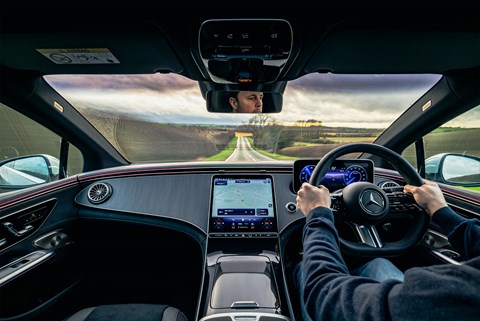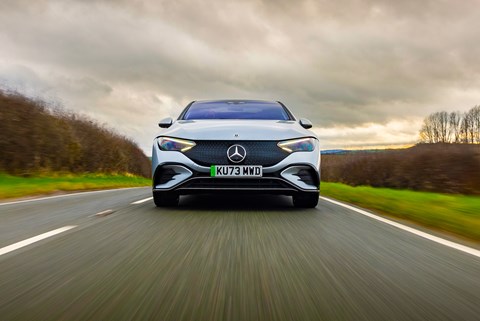► Our final report on life with a Mercedes EQE
► All-electric saloon is comfy and quiet
► But this much cash? And when it halves in value so fast?
Let’s be brutal about this – the EQE is unlikely to go down in the record books as one of the great cars in the long history of Mercedes-Benz.
It’s burdened by inelegant looks, numb steering and absolutely shocking brakes, and it’s not especially quick. This is not a list of positive traits lifted from How to Build a Car.
Lots to dislike, then. But as my time with the car went on I found the dislike fading into the background. That sounds a bit like when your mate says, ‘no offence but…’ and then launches into a critique of your worst character flaws. The point with the EQE is that it tends to make a poor first impression because of those disappointments listed above. But live with it for a while and its strengths come to the fore.
The brakes remain a big problem. You stop being surprised by them, but you don’t stop wishing they were better every time you drive the car. But the looks, the steering and the modest pace don’t grate so badly after a few weeks.

Rather, the EQE slips into the background, with an operating system that functions well, decent comfort and a general ease of use that makes it a very okay car. Its normality is its strength.
Take charging. The range increased from a low of 200 miles in foul winter weather up to a more acceptable 240 once the temperatures climbed. We saw a high of 3.03 miles per kWh while it was with us, with plenty of journeys in the 2.9s. That’s no better than middling efficiency, but the way the EQE typically made it pretty easy to use public chargers helps offset some of that.
By using the car’s nav, which intelligently links to charge points and can divert around traffic jams, the Merc took the stress out of journey planning. It found fast chargers where I never knew they existed, told me exactly how much I needed to add in order to make it home, and sucked the electrons in at 128kW thanks to the battery being pre-conditioned.
On one stop, I literally only had time to take a couple of photos before the EQE was ready to go again – six minutes and it had inhaled enough to make it home. It’s the closest I’ve got to Tesla’s ease of use in an EV not made by Tesla.
But does it have enough to elevate it above ‘white goods’ status? That’s a trickier question. It doesn’t drive as well as the universally admired Porsche Taycan or even the quietly impressive BMW i5. And, as I said in my first report, it lacks a USP that feels distinctly ‘Merc’.

Certainly the touchscreen, and more specifically the logic behind it, is impressive, but will that actually wow many people? It’s worked for Tesla. But that feels a bit shallow for a brand of Merc’s heritage. Finding charging spots in random pubs just off the A1 hardly has the same ring as Klaus Ludwig in a 190E through the Craner Curves.
We’re told that the successors to the EQE and the larger EQS will be built on modified versions of the current underpinnings, rather than the all-new platform previously touted. Given the slow-down in demand for EVs, you can see why Merc might want to adjust its priorities. But it suggests the EQE will continue to be slightly below par for another generation. ‘More of the same’ doesn’t sound like a great plan given how little appreciated the current EQE seems to be; you don’t have to look far to find a used car with less than 10,000 miles being offered for less than £50k.
An electric Merc to compete with the best of the brand’s history is an enticing prospect. But it’s not here yet.
Read month 3
Read month 2
Read month 1
Logbook: Mercedes EQE
Price £86,345 (£86,345 as tested)
Performance 89kWh battery, e-motor, 241bhp, 7.3sec 0-62mph, 130mph
Efficiency 3.3 miles per kWh (official), 2.4 miles per kWh (tested)
Range 337 miles (official), 220 miles (tested)
Energy cost 15.0p per mile
Miles this month 788
Total miles 2628
Count the cost
Cost new £86,345
Part-exchange £45,235
Cost per mile 15.0p
Cost per mile including depreciation £15.78